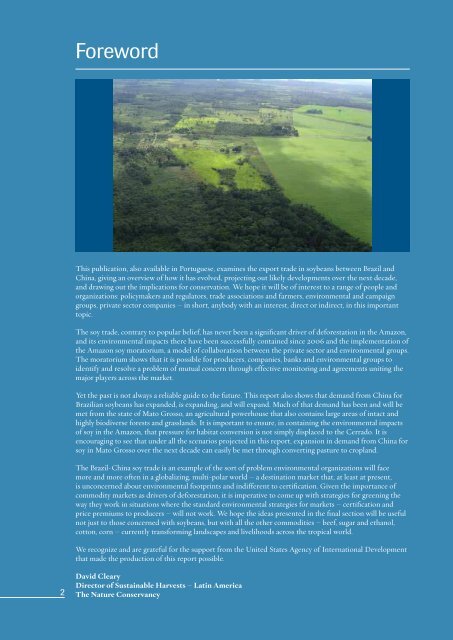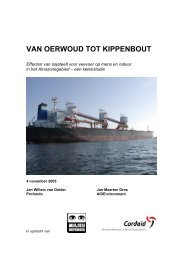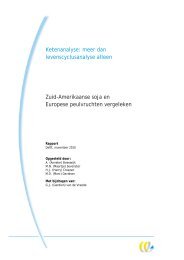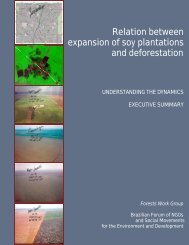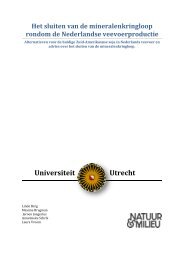Brazil-China Soybean Trade - The Nature Conservancy
Brazil-China Soybean Trade - The Nature Conservancy
Brazil-China Soybean Trade - The Nature Conservancy
Create successful ePaper yourself
Turn your PDF publications into a flip-book with our unique Google optimized e-Paper software.
ForewordTable of ContentsForeword..................................................................................................................................2Executive Summary.............................................................................................................4Part 1: An Overview of the <strong>Brazil</strong>-<strong>China</strong> <strong>Soybean</strong> <strong>Trade</strong>............................5<strong>The</strong> global soybean market..............................................................................................5<strong>The</strong> <strong>Brazil</strong>-<strong>China</strong> soybean trade: evolution and characteristics.........................9<strong>Brazil</strong>ian soybean production and exports...............................................................10<strong>China</strong> soy consumption and imports..........................................................................15<strong>China</strong> and the global soybean market.......................................................................17This publication, also available in Portuguese, examines the export trade in soybeans between <strong>Brazil</strong> and<strong>China</strong>, giving an overview of how it has evolved, projecting out likely developments over the next decade,and drawing out the implications for conservation. We hope it will be of interest to a range of people andorganizations: policymakers and regulators, trade associations and farmers, environmental and campaigngroups, private sector companies – in short, anybody with an interest, direct or indirect, in this importanttopic.<strong>The</strong> soy trade, contrary to popular belief, has never been a significant driver of deforestation in the Amazon,and its environmental impacts there have been successfully contained since 2006 and the implementation ofthe Amazon soy moratorium, a model of collaboration between the private sector and environmental groups.<strong>The</strong> moratorium shows that it is possible for producers, companies, banks and environmental groups toidentify and resolve a problem of mutual concern through effective monitoring and agreements uniting themajor players across the market.Part 2: Projections of the <strong>Brazil</strong>-<strong>China</strong> <strong>Soybean</strong> <strong>Trade</strong> to 2020...........19Introduction..........................................................................................................................19Business as usual...............................................................................................................20Better than business as usual.......................................................................................22Worse than business as usual.......................................................................................24Part 3: Strategic Implications for Conservation............................................26Converting pasture to cropland can meet all demand projections.................26Limits to certification as a strategy for the soy market.......................................29Alternative approaches to greening commodity markets..................................29Appendix: Exporters of <strong>Brazil</strong>ian Soy and Importers in <strong>China</strong>..............33Yet the past is not always a reliable guide to the future. This report also shows that demand from <strong>China</strong> for<strong>Brazil</strong>ian soybeans has expanded, is expanding, and will expand. Much of that demand has been and will bemet from the state of Mato Grosso, an agricultural powerhouse that also contains large areas of intact andhighly biodiverse forests and grasslands. It is important to ensure, in containing the environmental impactsof soy in the Amazon, that pressure for habitat conversion is not simply displaced to the Cerrado. It isencouraging to see that under all the scenarios projected in this report, expansion in demand from <strong>China</strong> forsoy in Mato Grosso over the next decade can easily be met through converting pasture to cropland.<strong>The</strong> <strong>Brazil</strong>-<strong>China</strong> soy trade is an example of the sort of problem environmental organizations will facemore and more often in a globalizing, multi-polar world – a destination market that, at least at present,is unconcerned about environmental footprints and indifferent to certification. Given the importance ofcommodity markets as drivers of deforestation, it is imperative to come up with strategies for greening theway they work in situations where the standard environmental strategies for markets – certification andprice premiums to producers – will not work. We hope the ideas presented in the final section will be usefulnot just to those concerned with soybeans, but with all the other commodities – beef, sugar and ethanol,cotton, corn – currently transforming landscapes and livelihoods across the tropical world.2We recognize and are grateful for the support from the United States Agency of International Developmentthat made the production of this report possible.David ClearyDirector of Sustainable Harvests – Latin America<strong>The</strong> <strong>Nature</strong> <strong>Conservancy</strong>“This study/report/audio/visual/other information/media product is made possible by the generous supportof the American people through the United States Agency for International Development (USAID).<strong>The</strong> contents are the responsibility of <strong>The</strong> <strong>Nature</strong> <strong>Conservancy</strong> and do not necessarily reflect the views ofUSAID or the United States Government.”3


